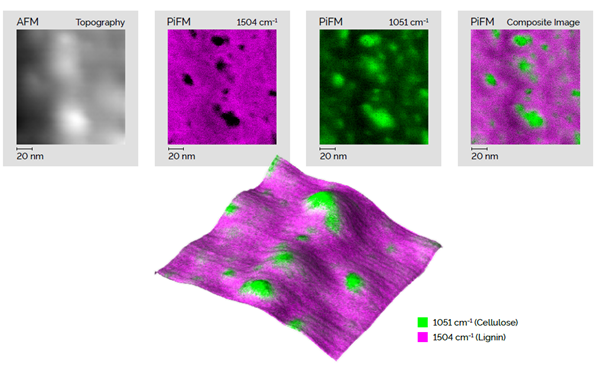PiFM and PiF-IR are the next generation of infrared spectroscopy techniques. PiFM brought a major shift to atomic force microscopy by adding chemical mapping capabilities. PiF-IR, its sister technique, is designed for measuring nanoscale spectra. But PiF-IR isn’t just a supporting tool—it’s a powerful spectroscopy method in its own right, expanding what’s possible across all types of IR spectroscopy, including FTIR.
While FTIR remains a reliable and versatile standard, it can’t keep up with the spatial resolution and surface sensitivity demands of modern nanomanufacturing. As precision and sensitivity become increasingly critical, PiF-IR delivers a level of performance that no other infrared technique can match.
Background
FTIR (Fourier transform infrared) spectroscopy is a well-established analytical technique used to detect and identify both organic and inorganic molecules. It’s effective for analyzing solids, liquids, and gases. For comparison with PiF-IR, however, this article will focus on its use with solid materials.
Most FTIR instruments function purely as spectrometers, providing a bulk measurement of the sample. This means they can’t capture spatial chemical variations, which is a significant limitation, especially when analyzing composite materials.
To address this, some systems combine an infrared microscope with an FTIR spectrometer to spatially resolve chemical features within a sample. While this setup offers some improvement, FTIR is still constrained by the diffraction limit of infrared light, limiting spatial resolution to around 5 microns. As a result, unless large quantities of pure material are available, FTIR’s utility can become limited.
PiF-IR, by contrast, is an AFM-IR technique that uses photo-induced forces (PiF) to analyze solid and thin-film samples with exceptionally high spatial resolution. These systems are built on atomic force microscopes, which naturally offer spatial resolutions down to just a few nanometers.
When infrared capability is added, the improvement in resolution and surface sensitivity is remarkable.
PiFM absorption maps can reveal chemical distributions with lateral resolution better than 5 nm, and PiF-IR spectroscopy can analyze volumes at least a billion times smaller than what FTIR can detect. This makes PiF-IR vastly more sensitive and localized than even the most advanced FTIR microscopes.

 To read on, please download the full article now!
To read on, please download the full article now!

Image Credit: Molecular Vista
Acknowledgments
Produced from materials originally authored by Molecular Vista.

This information has been sourced, reviewed and adapted from materials provided by Molecular Vista.
For more information on this source, please visit Molecular Vista.